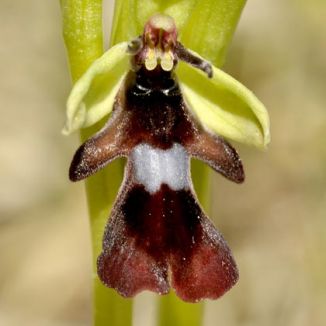The Fly Orchid is one of the small group of Orchids which mimic insects in order to attract visitors. 'Pollination by pseudocopulation' is the scientific term for this pretence whereby a plant emits the scent and has the appearance of an insect. By this impersonation, an insect is drawn to the orchid and while trying to mate with the flower, pollen is gathered onto its body to be distributed onto the next orchid. Fly Orchid is quite distinctive with its yellow-green sepals and the long, divided, red-brown lower lip of the flower. This velvety lip (or labellum) has a shiny, silvery-white band across it, just below the lip's two little lobes. It also has two tiny little red-brown upper petals projecting like tiny goat's horns. These flowers are carried in a loose spike of four to ten with long bracts curving upward behind each flower. There are usually three shiny oval leaves from which the stem arises, reaching about 45–50 cm. Fly Orchid blooms in May and June, it grows on limestone pavement, scrub and dry calcareous soils. A native plant it belongs to the Orchidaceae family.
I was so very fortunate to be shown this plant, growing in the Burren, by Dr Matthew Jebb, Taxonomist of the National Botanic Gardens, Dublin on a wildflower walk organised by Burren Beo. This was in 2010 when I also photographed it.
If you are satisfied you have correctly identified this plant, please submit your sighting to the National Biodiversity Data Centre




